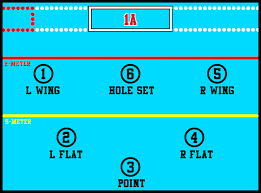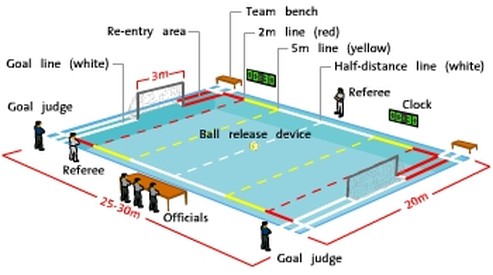If you’ve seen a Water Polo match have you wondered how in the world those guys can tread water so long without drowning? Is there a way to get around it during a game? Is a player allowed to touch the bottom in Water Polo?
Although not enforced much, touching the bottom of the pool is illegal in Water Polo, except in a goalie position. Players use a movement called an Eggbeater that enables them to tread the 6 ft. deep pool water for long periods of time during the match.
The first set of rules for the game was developed in 1885 by the Swimming Association of Great Britain. A player can swim more than 2 miles just in one game. This tough game of endurance is a mixture of basketball, football, soccer, and rugby and is very popular now in European Countries any gaining in the US.
Eggbeater Kick
Water polo is a very physical sport. There is a lot of contact among the players above water, and there’s a lot of contact below the water that you won’t see. Contact among players is the nature of the game, and actions such as pushing, pulling, grabbing, holding, and even sinking a player are allowed in Water Polo.
Although most times it will be illegal. Like Hockey, there are exceptions to the rules. It means that the sport is meant to be a rough sport. Under International rules, a water polo match is divided into four quarters of eight minutes.
However, because the clock is stopped when the ball is not in play which is the case for other professional sports, the average quarter lasts around 12 minutes. Positions are either offensive or defensive, with the offensive positions.
There are 2 referees that officiate the game and award fouls. One in the pool and another on the edge of the pool.
Players can move the ball by throwing it to a teammate or swimming while pushing the ball in front of them. They can only hold the ball with one hand, other than the goalkeeper who can use both hands.
Each team of 13 players must have seven players (six field players and one goalkeeper) in the water when the game starts. The visiting team’s field players wear white (or light-colored) caps, and the home team’s field players wear blue (or dark-colored) caps. The goalkeepers wear red or “quartered” (red plus another color) caps. Most teams structure their outfield players with one center back, one center forward, two drivers, and two wingers. Each team is also allowed a maximum of six substitutes one goalkeeper and five outfield players.
There are goals at each end of the pool and the team that scores the most goals within the time of the match wins the game. Players are not allowed to touch the bottom of the pool and have to tread water the whole time, although it’s rarely called. Water polo players use a movement called eggbeater which is more efficient than the normal action of treading water.
A polo ball is a ball used in water polo and canoe polo, usually characterized by bright yellow color and ease of grip-ability, so as to allow it to be held with one hand despite its large size. Like all team sports, Water Polo has certain playing positions for which individuals must be trained. Players can be substituted at any time during the match as long as it is between periods of play after a goal has been scored, or during a time-out.
Water Polo Positions
 The water in the pool is supposed to be deep enough for the Players to be able to tread water but it would be impossible for the referees to be able to see all the Players and all the positions during the game.
The water in the pool is supposed to be deep enough for the Players to be able to tread water but it would be impossible for the referees to be able to see all the Players and all the positions during the game.
Dimensions of the pool are not fixed and can vary between 20×10 and 30×20 meters. Minimum water depth must be at least 1.8 meters (6 feet), but this in reality is sometimes not the case due to practicalities. This gives players a huge opportunity to stand for a few moments at the bottom of the pool in plain sight of the referee.
Players can move the ball by throwing it to a teammate or swimming while pushing the ball in front of them. They can only hold the ball with one hand, unlike the goalkeeper who can use both hands. The match starts in a swim-off. this is where the referee throws the ball in the middle of the pool. The players are at both sides and chase the ball down for possession.
Water Polo positions are:
- Goalkeeper
- Defensive Specialist
- Driver
- Two Meter Specialist.
- Goalkeeper techniques and skills differ greatly from those required for field position players.
The offensive positions in a water polo game include a center (a.k.a. hole set), two wings (located on or near the two-meter), two drivers/flats (usually located at five- meters on the goal posts), and one point player (located at the five-meter mark), typically, in the middle of the goal. The wings, drivers, and point players are often referred to as perimeter players.
The typical numbering system for these positions begins with the offensive wing to the right side of the opposing goalie is called one. The flat/driver that is counterclockwise from position one is called two. Moving in that same direction, the point player is three, the next flat/driver is four, the second wing is five, and the whole set is the six.
 Water Polo uses Setups that are similar to defensive and Offensive Lineups in Football and Basketball. The most basic and popular offensive setup in the sport of Water Polo is known as a 3-3. It is given this name because there are two lines of three players in front of the opposing goal. Another offensive setup, used more commonly by professional teams, is called umbrella or “arc”, where perimeter players form an arc around the goal, with the hole set in the middle.
Water Polo uses Setups that are similar to defensive and Offensive Lineups in Football and Basketball. The most basic and popular offensive setup in the sport of Water Polo is known as a 3-3. It is given this name because there are two lines of three players in front of the opposing goal. Another offensive setup, used more commonly by professional teams, is called umbrella or “arc”, where perimeter players form an arc around the goal, with the hole set in the middle.
The Defensive positions are often mirrored using the same positions like the offensive positions, just switched over. Like most team sports, the defense can be played either in zones or man-to-man.
Defense can also be played as a combination of both zone and man-to-man in what is known as an “M drop” defense, in which the main defender sloughs off his or her defender into a zone in order to better defend the center position. In this defense, both wing defenders split the area that is farthest from the goal, allowing them a clearer lane for the counter-attack if their team steals the ball.
The goalkeeper position is one of the most difficult positions in water polo. A goalie must have the ability to jump out of the water, using just their core and leg strength, and hold that vertical position without falling down into the water, all while tracking and anticipating a shot. For a goalie to be able to cover the whole cage (goal), the goalie must be very fast and effective at both lateral movements as well as being able to quickly lunge out of the water to stop a shot. He uses his feet and legs to do this.
The Goaltender is the Quarterback of the team on Offense and Defense. He is shouting orders from the goal well above the water to players on where to line up or exposing weaknesses in the Defense. On Offense, he opens up the first play with a pass much like a Soccer Goalie and can even be involved with a score much like on a fast break-in Basketball.
Basic Rules Of Water Polo
- 2-Meter Rule says that an Offensive Player can not go through the 2-meter line without the ball. Much like offsides in Soccer or an Offside Penalty in Hockey. If they do it will create a turnover.
- 5 Meter Rule says that if you draw a foul outside the 5 Meter line then you are allowed to shoot the ball if you do it in one motion and in a timely manner.
- You can only have one hand on the ball at a time. If you use 2 it would be a turnover. The Goalie can use two hands on the ball only if he is not more than 5 meters from the Cage or Goal.
- Except for Goalies, Touching the bottom of the pool is illegal. It’s a foul for other water polo players to make a play for or with the ball while touching or jumping off the bottom. Referees typically won’t call it unless it’s obvious or results in an obvious advantage.
- The ball can be advanced by bypassing with one hand or dribbling which is swimming with your head above the water and the ball between your arms so that it rides on the wave created by the swimmer.
- Water Polo Teams only have 30 seconds to shoot. If they don’t then that’s a turnover.
Rules of Water Polo
The three types of Fouls in Water Polo are:
- Ordinary
- Major
- Penalty
Ordinary Fouls include:
- Touching the ball with two hands (with the exception of the goalkeeper).
- Taking the ball underwater when tackled.
- Impeding an opponent who is not holding the ball.
- Pushing off an opponent.
- Failing to shoot or advance the ball within 30 seconds.
Major Fouls Include:
- Kicking or striking.
- Deliberate splashing in the face.
- Interfering with a free throw.
- Misconduct or disrespect to the referee.
- Holding, sinking or pulling back an opponent who is not holding the ball.
Major fouls may result in a water polo player being sent out of play for 20 seconds. A player receiving three major fouls is removed from the game by substitution.
Deliberate kicking or striking an opponent results in the permanent sending off of the offending player. That means being kicked out of the match by the Referee.
Penalty Fouls:
Some infringements occurring within the 5-meter zone can result in the award of a penalty foul, if the referee deems the foul has prevented an almost certain goal, the water polo player taking the penalty throw has a free shot at the goal from the 5meter line, with only the goalie defending.
Water Polo is a mixture of a lot of different sports like football basketball and hockey mixed into one extremely difficult, physically demanding competition with athletes built for endurance.
The rules are clear. The need for players to tread water the whole time with the exception of the Goalie. This rule is basically broken for most of the game unless is blatant and caught by the Referee.
JimGalloway Author/Editor

References: article called The Rules and Regulations of Water Polo

